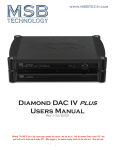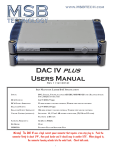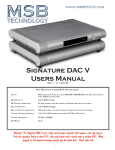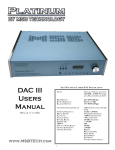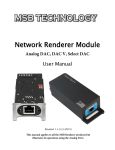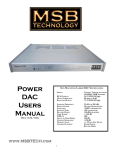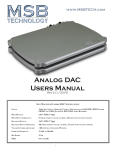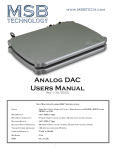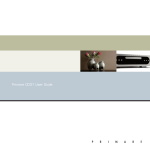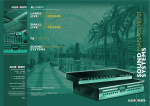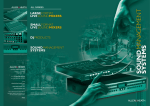Download MSB Technology Diamond DAC IV Specifications
Transcript
Diamond DAC IV SELECT Users Manual Rev 1 (4/2014) 1 DAC IV SELECT Users Manual Unique Product Concept The Diamond DAC IV select is MSB’s reference DAC for the future. The select model started life as a fully loaded Diamond DAC IV in which all the options are included as well as an exciting 10 year warranty and upgrade guarantee. But that is just the beginning. Each month we add new improvements. Not only does it have the very best diamond DAC modules, Galaxy Femtosecond Clock, EURO heatsinks, 384 kHz USB input and Diamond Volume controls -- but now has a number of major improvements including a new heavy duty power link with additional power supplies to further isolate the clock. It also has lots of hardware improvements including some new technology we are not even talking about. Its all included, burned in and carefully tested, including actual listening tests in our reference system. As we are developing improvements and new ideas, they are immediately incorporated into this DAC, so unlike normal products, each month the select model will be different, and from time-to-time the cost may increase. But don’t worry, you can upgrade as often as you want, so you will never be left behind. The select model comes with a 10 year warranty and upgrade guarantee so as we make improvements, you can return your DAC and get the latest performance without having to worry about selling the old model and buying the new one. These upgrades are free for the first year and simply the difference in cost between your DAC and the current select DAC for the remaining years. Guaranteed, no questions asked. Upgrade as often as you like. CD, Universal Transport Phono Preamp Analog R/L Digital DAC IV Analog R/L AMPs DAC and PREAMP Together The DAC IV has one analog input with the option for a second, and many digital inputs. It is designed to be the last component in your system before the amplifiers. With its incredibly low impedance, especially for a passive preamp, it can drive long interconnects and handle any type of amplifier input stage design with optimum performance. Depending on how many analog sources you have in your system, you may be able to eliminate your current preamp. If you currently have only CD and vinyl in your system, you would attach your CD players digital output to the DAC IV and the output of your phono preamp to the analog input. Your system is now complete, with the shortest possible signal path and the best sound you can achieve. If you have a complex system with a preamp with many analog inputs, attach the outputs of your preamp to the input on the DAC IV. Shift any digital sources over to digital inputs on the DAC IV and again, you will achieve optimum results. Set your preamp to a volume that matches the DAC IV output and use nothing but the DAC IV volume control in your system. Setup and Quick Start The front panel is quite simple with few user controls. Input source select defaults to auto. On power up, the volume is reset to -30 dB. Turn the volume knob up until you hear music. Power - The Diamond comes with a high performance outboard power supply. The supply automatically detects and switches between 240V and 120V. This is not a switching supply that works at any voltage, but a linear supply with automatic switching of the transformer leads. The power supply is switched on and off with a toggle switch on the back. It can be remotely controlled when the front panel control option was installed. Always allow three to five hours for the Diamond to warm up and reach thermal equilibrium. Inputs - The Diamond comes standard with one MSB PRO I2S (CAT6), USB2, AES/EBU balanced, coaxial (RCA and BNC) and optical digital audio inputs, as well as a balance analog input, ranked in order of performance. Connect any digital input to any active digital audio source. The frequency and bit depth of the incoming signal will be read out on the front panel and analog audio will be found on both balanced and single-ended analog outputs. Outputs - Connect the balanced analog outputs to any amplifier and audio should be present. If you ordered your SELECT for single-ended use, there will be no balanced outputs. The output level is controlled with the knob or remote. Burn-In The concept of burn-in is little understood. The feedback we receive leads us to recommend at least 100 hours of burn-in on this DAC. Customers generally report improvement up to one month. Warning: Please verify that the DAC IV you just purchased is covered under warranty. This DAC was sold to the Distributor named on your box label. The country and date of manufacture is also specified. If the country and year do not match your purchase location, your warranty may be invalid. Check with MSB. PLEASE FILL OUT THE REGISTRATION CARD The 10 year warranty and UPGRADE Guarantee is ONLY extended to the original owner as registered. Failure to register puts your warranty at risk! The card is in the back of this Manual. 2 The Signature Data CD is a great companion to the DAC IV. It is shown here with the Signature Transport Power Base in Satin Black. MSB offers two Amplifiers, the Stereo S201 and the M203 Monoblocks, available in Matt White or Satin Black. Sign Magnitude Ladder DAC Specifications Inputs: BNC, RCA, Toslink, XLR AES/EBU, USB2, MSB PRO I2S and Balanced Analog Inputs RCA Outputs: RCA Output Impedance: 2.62 V RMS (7 Vpp) 53 ohms without volume controls, 38 ohms with volume controls Balanced Output: Balanced Output Impedance: 5.23 V RMS (14 Vpp) 106 ohms without volume controls, 76 ohms with volume controls Volume Control: 1/4, 1/2 or 1 dB stepped attenuator, (78, 156 or 312 steps) Sampling Frequency: 32 kHz to 384kHz Bit Depth: 32 bit 3 Unique Technology - the past and the future In the 1980’s early DACs were all 16 bit ladder DACs, with a precision laser-trimmed resistor creating the appropriate analog level for each of the bits. The DACs worked well and sounded good. They were quite expensive as very accurate resistors were required. Then along came the “single bit” DACs. Rather than using a resistor to create an analog level, pulse width modulation was used. Basically each bit was created by turning a switch on and off for the appropriate length of time. The resulting square wave pattern was filtered to create a smooth output. The expensive resistors were gone, and so was the good performance. Next came the Delta Sigma DAC. It used the same pulse width modulation but rather than creating a single large pulse for each data point, the data point was created with many small pulses. This allows the pulses to be smoothed with a less radical filter, and improves the sound. As you can see, upsampling the input signal to a higher frequency reduces the filtering requirements and thus improves the sound. Right Channel MSB DAC Module (Non-inverted signal) 23 bit positive sign DAC Toggle Switch 23 bit negative sign DAC MSB DAC Module (Inverted signal) Coaxial Out 23 bit positive sign DAC 23 bit negative sign DAC Balanced Out Block Diagram The DAC IV draws from the older, superior ladder technology, but with incredible improvements. The Basic Diamond contains four 24 bit MSB DAC modules (seen below). The Diamond is fully balanced so there is a matched pair of 24 bit DAC modules for the inverted and noninverted signals on each of the right and left channels. Finally, each DAC module contains one R2R ladder DAC with a 23 bit negative sign and one R2R ladder DAC with a 23 bit positive sign. Together this makes a true 24 bit DAC. This design allows the quieter moments in your music to be true to the music, without the linearity errors near zero that plague normal ladder and delta-sigma DAC designs. With a dual 24 bits of combined resolution, a 24 bit source gives a true 24 bit resolution without the losses and errors that make your normal 16 or 24 bit DAC perform far less than their actual resolution (normal 16 bit DACs only muster a meager 12 bits of resolution). Second Generation Platinum DAC module - Smaller but more bits! The DAC IV is carefully designed so as to require no DC correction in the output stage. This allows direct DC coupling on the output stage for pure, uncolored sound -- with no output filtering to muck up your high end or smear your bass attack. Another major difference in the DAC IV is the type of output. Essentially all ladder DACs produce a current output. This is converted to a voltage output with a current-to-voltage converter. This problematic circuit colors the sound and introduces nonlinearity. The DAC IV is a true voltage DAC with a voltage output right from the source. All amplifiers have slew rates greater than 1000 Volts/microsecond. The output impedance of the DAC IV is 53 ohms. Original Platinum DAC module The Diamond contains four 26 bit DACs, twice the number of steps as the Signature DAC IV. Special Features The DAC IV has many special features. The following sections discuss these features and how they work. As MSB Technology has developed, so has our DAC architecture. Our advanced digital filter now replaces the asynchronous upsampling of earlier models. The 32X Digital filter goes way beyond our older 16X filter and 4X upsampling. To play a 32 bit/384 kHz file the Diamond only needs to be plugged into the MSB Data CD IV player and a DVD with a 32/384 .wav file needs to be played. The new reclocking feature dynamically buffers and re-clocks all the data and clock signals to provide a virtually jitter-free source directly to the DACs. 4 THE DAC STORY How DACs work Delta Sigma DACs (Single Bit) Each sample or jug is filled to the right level with many measuring cups, poured to reach the target level. 010010100011101000110110 A DAC is a circuit that converts digital measures of audio amplitude in discrete steps into a continuous analog electrical equivalent of the sound to be reproduced. The amplitude is a digital number (like a 16 bit word) and the steps occur based on the sampling rate (like 48,000 times per second). This process is very much like an endless conveyer belt with empty one gallon jugs on it, moving by a filling station. The size of the jug is fixed, the rate they pass by is determined by the sampling rate. The goal of the DAC is to fill each jug to exactly the right level specified by the music. There are three techniques used to accomplish this; Delta Sigma, Ladder, and the MSB Sign Magnitude Ladder. A ladder DAC is different in that instead of a single measuring cup (or bit), a whole array of cups are available, from very small to very large. Ladder DAC Any combination of cups can be used to fill each jug to exactly the right level. Line speed is like Sampling Rate (48,000 per second) By keeping a running tally of the error and by going a little over and a little under in many many samples, a very accurate average is reached, but only with an aggressive filter applied to the output. No filtering is required but the accuracy is defined by the cumulative error of all the cups used. What about Jitter? Jitter is a variation in the speed of the conveyer belt. With a Delta Sigma DAC, the quantity of water ending up in the jug is dramatically affected by the speed change because the whole cycle is occupied with the application of many small scoops of water. With either Ladder DAC method, all the water is placed in the jug at the same time, and even if the jug is a little ahead or behind in the conveyer belt, the quantity is still accurate. That is why we never heard much about jitter until the first Delta Sigma DACs arrived on the scene. A “one bit” measuring cup is either full or empty. With 64 times oversampling, the cup is only 1/64th the volume of the jug. This rather crude cup does not come close to being accurate enough. The cup would need to be 1/16,777,216th the volume of the jug to be accurate. MSB Sign Magnitude Ladder DAC The MSB Sign Magnitude Ladder DAC is like a Ladder DAC but refined in two ways. Because the jars are typically 1/2 full when finished, we start with very accurately 1/2 filled containers instead of empty ones. From there, we again use the wide range of measuring cups to either add or take away from each jar. Again each jar is filled exactly so no filtering is needed, but because we only had to add or subtract a little bit our accuracy is higher. Because our hearing is most sensitive to low level sound (sound near the 1/2 full zero crossing) our DAC is most accurate near 1/2 full where we use the smallest and most accurate measuring cups. What about Upsampling? Synchronous Upsampling like MSB does just means adding more jars between the existing jars and moving them faster down the line. By looking at many jars before and after the new empty one, we calculate how full to make it. The result is smaller steps as shown in the waveform. The MSB Diamond DAC No commercial DAC is available with the level of accuracy we wanted without filtering, so we produce our own using discrete logic and resistors in a DAC module. MSB is unique in this respect. The result is a signal-to-noise rating of up to 160 db and THD+Noise ratings near the theoretical limit of a 24 bit source. 5 Upsampling Upsampling has been in and out of vogue for many years. Its benefit has been obvious in one DAC and nonexistent in another. We do not do upsampling as such in the SELECT model. We have the accuracy and precision which is compromised with upsampling. Custom MSB Digital Filter The DAC IV has a custom DSP based Digital filter. The sine x function is the ideal shape to apply to the audio filter task, but unfortunately to work perfectly it must sample an infinite number of samples. Our 16x filter contained 3200 taps, a very large sample and worked well. The 32x Filter contains and amazing 6000 taps, and the increased size of the filter more closely approximates the ideal filter. Immediately you can hear the increased clarity of the music. MSB has applied noise shaping technology, not directly to the audio as SACD and Delta Sigma DACs do but to the actual digital filter. This novel approach reduces that digital harshness without loss of detail or focus. Just as glasses bring an image into focus for eyes that are not perfect, we have applied a corrective algorithm to the slight imperfections specifically found in our DAC architecture. This new innovation focuses the instruments more accurately on the soundstage. About the Clock / Jitter Control Jitter control devices (and inputs on most DACs) normally reclock the input signal in attempt to lessen the jitter of that incoming signal. The DAC IV does no such re-clocking. We actually pay no attention to the clock on the input signal. All internal clocks are generated by an extremely accurate plug-in clock. Since the input clock is no longer related to the clock of the DAC IV, an intelligent ½ second buffer is used to maintain data synchronization. A clock header is a part of the DAC IV that will allow even more accurate clocks to be installed as an upgrade as they become available. Clock jitter seems to be the single biggest contributor to digital harshness. MSB clocks are the lowest jitter audio clocks in the world. The DAC IV plus models are supplied with the Femto 140 Clock with about 140 femtoseconds of jitter. The SELECT comes standard with the Galaxy Femtosecond Clock which offers about 77 picoseconds of jitter. 6 MSB Digital Filter History and Detail One of our primary goals at MSB is to provide the music lover with the most accurate musical experience possible. During years of careful design and improvement of our custom discrete DACs, which form the heart of your Diamond DAC, we realized that the Diamonds sound quality was no longer limited by them. We next narrowed the problem to the Digital Filter which was feeding our DACs. While the excellent Burr-Brown (Now owned by Texas Instruments) DF1704 Digital Filter had served us well in the past, it had became the bottleneck once we started using our new Second Generation DAC modules. After a thorough search of all the available off the shelf and custom DSP based Digital Filters we realized that little improvement could be had from any of them. With no other option in sight we decided to build our own solution. Converting the ones and zeros of Digital Audio into music is an enormously delicate and critical process. Each individual sample that makes up the audio stream must be converted into the high resolution, continuous analog voltage that can be transformed into the sound that you hear. Any misstep can corrupt the final result ending with audio that does not sound anything like the original recording. Errors in translation can make a harsh, veiled, muddy, and/or tonally colored result. Minimizing each potential problem allows the original recording to shine through. Audio reproduction starts when the DAC receives the binary coded information from the source. The first step requires recovering the audio samples, which represent the final output voltages, and the timing, which tells the DAC when to output those voltages. Next the sample rate is raised and the data is digitally filtered. While it is possible to feed the DAC with the original audio samples thereby avoiding the use of a digital filter skipping this step has many unintended consequences. After being digitally filtered the digital stream is feed to the DAC. The DAC receives the digital audio samples and converts them into a continuous analog voltage. Our DACs instantly convert the data into a precise continuous voltage waveform with timing determined by the DACs conversion clock. The digital filter is necessary because mirrored image frequencies created during the conversion process must be removed. If the DAC did not have a digital filter, an analog filter with an aggressive response must remove these image frequencies. These brick wall analog filters seriously damage the signal by corrupting the original phase of the sound and cannot fully remove the high frequency images. This results in harsh or rolled off high frequencies and poor soundstage focus. Traditional digital filter designs consist of cascaded FIR (Finite Impulse Response) filters, each of which raise the sample rate by two. The intermediate data between the filters is usually stored at less than 40 bit resolution. Since the next filter works with previously computed data the resolution decreases with each filter pass. This limits higher quality digital filters to a low oversampling rate (usually 8x) before the output starts to deteriorate. The loss in resolution is typically not apparent when using the best conventional digital filters with standard DAC chips, but in combination with our high resolution DACs the problem is very apparent. The sound becomes muddy, veiled and un-involving when using any off the shelf digital filter. To counter this problem the MSB Digital Filter does it’s filtering in one filter stage that raises the sampling rate by 32. FIR filters operate by multiplying each sample in the data by a set of filter coefficients and then summing the result. Most digital filters round the result of each addition before the adding next sample. This repeated roundoff results in a similar problem to the cascaded 2x filter approach, muddy sound. MSBs digital filter uses bit perfect accumulation in an 80 bit accumulator completely eliminating these debilitating roundoff errors. Only as the last step do we carefully convert the audio to the 24 or 26 bits our DACs require. The high sampling rate of the output allows us to include advanced ultrasonic dither and noise shaping techniques in this step to achieve greater than 24 bit effective resolution. Through extensive listening tests we have found that the choice of filter coefficients has a great impact on the tone of the music. We have found that steep, phase perfect “Brick Wall” filters tend to sound the most neutral but are also the most difficult to implement without problems. Improvements we have made in our digital filter, with its single stage design and 80 bit computation, allow us to use very steep filters with no compromises. Standard Balanced Rear Panel Analog Details - (left to right) Right Analog Single-Ended RCA Output – This is the primary single ended RCA analog output. It is a non-inverted copy of the Balanced out with one bit less resolution than the balanced output. The output impedance is 38 ohms with volume control and output level is 7 Volts PP (2.62 V RMS). Right Analog Single-Ended RCA Alternate Output – This is the alternative single-ended RCA analog output. It is the exact same as the first RCA output except inverted. When the optional Second Analog Input upgrade is installed, this becomes a single-ended analog input. As an input, this line should be terminated or connected to a source as it is directly connected to the output when the DAC power is turned off. Right Analog Balanced XLR Output – This is the balanced XLR analog output. The output impedance is 106 ohms with volume control, and output level is 14 Volts PP (5.24 V RMS). Right Analog Balanced XLR Input – This is the balanced analog input. This input can be either volume controlled or not, depending on the menu settings. This input is ideal for adding a vinyl input to your system. Minimum input impedance is 2 kohms. At 0 dB volume setting, the analog inputs are a direct pass-through. Left Analog Connections – Same as right above. Aux One and Two – A second balanced analog input can be installed here, instead of the single-ended option. It can use or bypass the volume control independently of the first analog input. (These are normally used for the USB input and any extra digital input) Single-Ended Configuration Rear Panel Analog Details - (left to right) Right Analog Single-Ended RCA Output – This is the primary single ended RCA analog output. It is an optimized output with the same resolution as the balanced output. The output impedance is 38 ohms with volume control and output level is 7 Volts PP (2.62 V RMS). Right Analog Single-Ended RCA Alternate Output – This is the same output again. Right Analog Balanced XLR Output – None. Right Analog RCA Input – This is the RCA analog input. This input can be either volume controlled or not, depending on the menu settings. This input is ideal for adding a vinyl input to your system. Minimum input impedance is 2 kohms. At 0 dB volume setting, the analog inputs are a direct pass-through. Right 2nd Analog RCA Input – When the optional Second Analog Input upgrade is installed, a second single-ended analog input is added. As an input, this line should be terminated or connected to a source as it is directly connected to the output when the DAC power is turned off. Left Analog Connections – Same as right above. How to Hook Up a Subwoofer Main AMP Balanced – Use the main single-ended output for Subwoofer. (Preferred Configuration) Main AMP Single-ended – Use the alternate single-ended output to connect to the Subwoofer. If the subwoofer is powered, we would strongly recommend using our SUB ISOLATOR product to protect the DAC from interference. It makes a huge difference. Powered Subs almost always use switching power supplies or Class D amps which feed high-frequency noise back up the analog input The SUB Isolator does a great job of isolating your DAC to the DAC. from Subwoofer power supply noise. 7 Rear Panel Digital Details - (right to left) The MSB PRO I2S Network Power Input – This product must be plugged into a DAC IV SELECT Power Base. It will not work with any previous MSB power supplies. One of the most powerful features of MSB products is the PRO I2S network. Most new MSB products have a PRO I2S connection available. The MSB PRO I2S has the following capability: RS-232 – The RS-232 input is used for controlling the DAC or volume control using a remote system. The complete table of commands can be found under the support tab of our web site. • • Toslink – Although this format has the lowest bandwidth, it is one of the more common outputs on low-end products. It also offers ground isolation between products and noise immunity over long runs. It is unlikely to work at sample rates over 192 kHz. Coaxial – A good input for short runs and lower frequencies. Limited to 384 kHz, 24 bit data. BNC – Same as Coaxial but with a BNC connector. Another digital input. Balanced digital – The AES/EBU Professional input is the preferred standard input. The balanced nature of this input allows great cable lengths as well as total noise immunity. Limited to 384 kHz, 24 bit data. MSB PRO I2S – The MSB PRO I2S uses CAT-6 cabling. It provides an input for use with other MSB products. It can handle data up to 384 kHz and 32 bits. This interface also outputs the clock to keep the transport in sync. • • Works with standard UN-SHIELDED CAT6 cable Simultaneous transmission of 8 audio channels with 32 bit resolution at 384 kHz sampling rate. MSB CAN Interbox communication Bus (for communications between boxes) Low Jitter master clock distribution from the DAC back to the Transport. This network is our answer to 384 kHz audio transmission and multichannel transmission in the same package. We provide network outputs on our own transports and offer a source upgrade to your transport as well. With multichannel sources, up to 8 channels of decoded data can be sent through one wire to separate DACs. CAT6 wire is very convenient as it has become the standard for all computer networks. Several cables are available for connecting MSB transports to the Diamond Line including CAT6 cable at any length up to 80 feet. MSB Signature USB2 – This USB input is installed in one of the AUX positions so that as USB changes, it will be easy to upgrade the input. It can handle data up to 384 kHz and 24 bits. It requires computer power so please use standard USB cables. See the box below for setup. For more detailed and up-to-date information check our web site. Aux 1 and 2 – These are all purpose expansion slots. They can be configured as a USB input, MSB PRO I2S Input, MSB Network or extra XLR or RCA digital inputs. It can also become a second analog input. They will also accommodate anything new that comes along. Apple MAC OS - USB Setup On the MAC the USB is plug and play. The MAC will recognize the USB DAC and its capabilities and will allow the output to be set to any sample rate desired. The bad news is, with certain programs such as iTunes, the output sample rate has to be set manually when the file sample rate changes. So if you set the output for 192 kHz, and played a 192 kHz file, it would play perfectly, but if you then played a 44.1 kHz CD, the MAC OS would upsample that file to 192 kHz. Computer upsampling is not too bad, but does not compare at all with the quality of the upsampling done by MSB. Better to change the output to 44.1 kHz and play the file bit-perfect. Fortunately there is an APP called BIT PERFECT. Download it and the MAC with the MSB USB 2 is perfection itself. The Apple Audio MIDI Setup screen is shown above. Notice that the presence of the MSB USB Signature DAC has allowed 352.8 and 384 kHz sample rates to show up on the menu. Normally they are not present. iTunes will play at whatever sample rate you select in this setup. 8 Windows OS - USB Setup The amazing thing about the MSB USB 2 input with Windows is that once you get it set up it works completely and absolutely perfectly, with every file playing bit-perfect at its native sample rate up to 384 kHz with no user intervention. Just pick the song and play. The rest is automatic and works perfectly. This is a first for any Windows machine I have seen and a dream come true. The bad is that MSB drivers will have to be installed, and your music must be played with a properly set up player program like Foobar. Its a small price to pay for perfection, and MSB will help walk you through the process. First, install the supplied MSB drivers from the included USB 2 drivers CD or from our website. So with a PC, there are two possible play modes. The “advanced speaker properties” window lets you set up Windows output sample rates up to 192k as shown to the right. Any audio played by an audio program would be output at this sample rate. Specialty programs like Foobar can be modified with a plug-in, like ASIO (http://www.foobar2000.org/components/view/foo_out_asio) which allows Foobar to interact directly with the MSB DAC to play every music file at its native sample rate bit-perfect. Foobar over-rides all windows settings and is quite amazing. Clock Interface After years of experimenting with inputting and outputting clocks we now strongly recommend not doing this. A low jitter clock must be physically close to the DACs. There is no lower jitter clock than the MSB clocks, and even if there were, once the clock was transmitted from an external box so much jitter would be introduced in the cable that the clock would be marginal at best. So we are confident that no benefit would be gained from an external clock. A different set of problems exist with outputting clocks. A paradox is created as a source needs a clock to transmit data, but when the DAC sees the data, which can be at any sample rate, it adjusts the clock to match. Most sources cannot handle its clock adjusted on the fly. The MSB Transports can handle this as the PRO I2S interface is smart and negotiates the proper clock to be sent back to the transport. But as new sources have this ability, and you need to access this clock, it can be done. The MSB CLOCK ADAPTER allows the DACs master clock to be output. The BNC output is a LVDS level 512x master clock output that can be used to keep a server in sync. This is a great upgrade and has already been approved by Aurender. Clock Frequencies - The clock output frequencies are as follows: · 44.1, 88.2 or 176.4 kHz sampling frequency source outputs a clock frequency of 22.5792 MHz · 48, 96 or 192 kHz sampling frequency source outputs a clock frequency of 24.576 MHz. The Clock adapter allows the DAC clock to be sent to your server or transport so the system stays in sync. 9 Front Panel Controls Although the user interface is very simple and easy to use, in depth menus allow complete control of the DAC. Menu Button – The square button is single purpose. It will enter the setup mode at the top of the menu tree. If in the setup, and it doesn’t matter where, this button will exit the setup and return to the normal operational mode. Input Selection – Each of the six inputs can be selected manually, or the auto mode can be selected. The auto mode is an automatic priority switching with auto signal detection. The right and left arrows switch inputs. If the AUTO input is selected, the unit will automatically switch inputs based on a priority (from left to right - Analog = lowest priority, MSB 2 = highest priority). When a source with a higher priority becomes active, the unit will automatically switch to the new higher priority input. Toggling through the inputs manually will defeat any auto switching. When in the setup menu the arrows move right and left through the menu structure. Star Button - The star button is used to do phase invert. Input/Volume Knob - The large knob will select between inputs if the volume control option is not installed. The right and left arrow buttons on the front of the unit will also switch between inputs. When the volume control module is installed, the knob becomes the volume control. This knob adjusts the volume between +9 dB and -69 dB. Our 0 dB actually equates to a 2.62 V rms output, just a little high in relation to the industry standard 2 Vrms level. Display - The display shows the Input in the upper left. The lower left shows the input sample rate and bit depth. The right shows the volume. Remote The MSB remote can be used to operate several MSB products. The top half is primary for the transport. The center is for the DAC and the lower part for the iLink. Power – The power button turns on and off the Power Base when the optional front controls have been installed. If your Diamond Power Base does not have a switch on the front, this button will do nothing. When the power base is linked to the Amplifiers and any other MSB products, this button will turn off the entire system. (see power base manual for details) Data CD IV controls – . The keypad, stop and repeat buttons are for the DATA CD IV transport and have no effect on the DAC IV. Volume up and down – The center block of the remote has several functions. The volume up and down buttons change the system remote if the optional volume controls are installed in the DAC. Steps sizes are shown on the DAC display. The mute button instantly mutes the audio if the volume option is installed. < > = * and # buttons – These central buttons are also for controlling the DATA CD IV transport, but also can be used for navigation of the DAC IV menus. See MENU below. Input – This button toggles directly through the inputs of the DAC IV even if the DAC is set to the auto mode. Menu – This is equivalent to pressing the menu button on the front panel and puts the DAC IV into the menu/setup mode. The menus can be navigated from the front panel or using the < >, volume up/down buttons on the remote as left, right, up and down. 1, 2, 3 – These are SELECT defined buttons set as follows: 1. Phase Invert - Toggles phase invert on and off. 2. Video Mode - Toggles reclocking on and off. This is especially useful for watching movies, where reclocking may cause an objectionable audio delay. 3. Display On/Off - Toggles the display on and off. Batteries – The remote control requires two CR2025 Lithium batteries. 10 Operational Menu Options The high level menu options have to do with operation settings. They are things that you may want to change on the fly as you listen to different music or with different equipment. See the Menu tree for details. Phase Invert - Toggling the Phase Invert will change the absolute phase of the output. There are some recordings that “accidentally” swap the phase. For those who are phase sensitive, we always include this option. The phase of the outputs is inverted digitally. User Button - Defines the function associated with the user button * on the front panel. Remote User Buttons - Defines the function associated with the remote user button 1, 2 and 3 on the remote control. About - Displays information about the unit including the version number, serial number, distributor, and year of manufacture. Setup Menu Options The second level menu options have to do with setup parameter - things you will only need to set once. In most cases you will not need to change any of these settings. See the Menu tree for details. Video Mode - This very important feature of the DAC allow all jitter to be removed from the input source. Data is read into a memory and then independently read out using a ultra stable clock. When enabled this option will completely replace the incoming clock with an ultra low jitter internal clock. The DSP monitors the incoming sample frequency and detects standard sample rate signals, 44.1 kHz, 48 kHz, 88.2 kHz, 96 kHz, 176.4 kHz, 192 kHz, 352.8 kHz and 384 kHz. The on-board clock then completely replaces the incoming clock. Other sampling frequencies use the incoming clock from the source. The DSP allocates a huge internal FIFO buffer (1/2 second at 44.1) that stores the incoming audio to decouple the incoming and outgoing data streams. Long absolute digital silences in the music stream, such as between tracks and during pauses, are selectively shortened or lengthened by the DSP to maintain data synchronization. This results in a significant delay between the audio source and the analog audio. You will not normally notice this delay unless video is synchronized to the audio. For this reason this feature may want to be turned off when watching video, or the video should be delayed. While using the on-board clock some very long musical performances greater than one hour with no silences, pauses or track skips may cause a buffer overflow when using a standard transport. This will sound like a small CD skip. You will probably never encounter this case but if you do MSB can install a special ultra high accuracy clock in your transport or other audio source to totally eliminate this possibility. Display Brightness - Adjustable from 1 to 15. Display on/off - When turned off, the display pops on for a bit any time anything is adjusted, then turns off again. Restore Settings - Puts settings back to factory default setting. Startup Volume - This is the volume setting that is set upon power up. Maximum Volume - This is the maximum volume setting that can be reached. Use this feature to protect your speakers. Fine Volume Steps - The Select volume modules allow half or quarter db steps to be inserted between the standard 1 db steps. In most cases this level of resolution is not audible. Input Setups Analog Input Volume Control - The analog input can either be volume controlled or bypass the volume control. Alternate Analog Input Volume Control - The alternate analog input can either be volume controlled or bypass the volume control if this option is installed. Switching Mode - When the input selector is manually selected, either all inputs are available or just active inputs. With active inputs selected, A/B testing is very quick and easy. MSB Network Channel Select - The MSB Network supports 4 stereo channels of audio. With this feature the DAC can be configured to decode any of the 4 sets. 11 Phase Invert Analog Input Off Disabled Enabled On Video Mode Analog In 1 Volume Audio Controlled Bypassed Video Display Brightness Dislay On/Off Analog In 2 Volume 1-15 Controlled Bypassed DSD Decode On On Off Auto Off Startup Volume Maximum Volume MSB Clock 0 to -69 dB Input No Limit Switching Mode -30 to +6dB Fine Volume Output All Inputs Active Inputs Standard Network Channel 0.5 dB Steps Analog Ground Off Channel 1-4 0.25 dB Steps Connected Lifted Input Setup RS232 DAC IV SELECT Menu Tree On Off Top level menus are for operational controls. Setup menus are in the second column. • Press the menu button on either the front panel or remote. Restore Settings About Cancel • Navigate up and down the options with the front panel knob or the volume up down buttons on the remote. Restore? • Use the arrow buttons to navigate right and left in the menus on either the front panel or remote. Displays information about DAC • Use the * button on the front panel or the > button on the remote to select. The default settings are shown on the chart in a bold box. 12 Upgrades and Modifications Removal of the cover - Unplug the AC power. Work on a clean surface. Start by removing the 14 screws of the cover. Carefully remove and set aside the cover. Removal or Installation of the volume modules - The volume modules can be plugged in, or unplugged from the Diamond mother board. They are held in place with their two connectors. The boards are automatically detected, so when unplugged the DAC will output the same level signal as it would with them plugged in at 0 dB. The volume knob will now select the input and the remote volume buttons will have no effect. Other Upgrades - Check the instructions supplied with the upgrade. PRO input Upgrade This upgrade adds one or two additional MSB inputs in the AUX IN positions of the DAC IV. It is a flexible board so please be careful to check the instructions carefully when installing. The upgrade offers two possible inputs: Input #1 - Ground Isolated MSB Network This is an improved version of the classic MSB Network. It will work with all existing MSB Network outputs on all current and older products. This input is designed specially as the best possible input for the MSB Universal Media Transport. It has the performance of the stock MSB Network without the coupling of ground noise. With this input both our transports can have optimal inputs. It will work with the following: • Data CD IV • Universal Media Transport • all older MSB products Input #2 - MSB PRO I2S The MSB PRO I2S is new and will offer amazing performance on new transports as they are brought to market. It is lower jitter and higher speed (ready for 768 kHz music) than the MSB Network. It contains 20 channels of audio of 768 kHz, 32 bit audio in the I2S format, as well as a an outgoing clock and control data. These can be used to send multichannel data as would be required with digital crossovers, distribute independent super precision clocks and do auto setup of DAC parameters. Future upgrades and products will allow MSB products to take full advantage of these new capabilities. There is an PRO I2S output on our Studio 384 kHz, 32 bit ADC and this output will become the standard output on all new flagship MSB transports. So this input works with: • MSB Pro Analog-to-digital Converter • Signature Data CD • Universal Media Transport PLUS and Signature Universal Media Transport, and all new products to come The MSB PRO Input board upgrade not only gives you the improved MSB Network input you can use today, but also gives you a PRO I2S input that will be available for new MSB products in the future. The PRO upgrade can easily be configured for either type input. Operation These new inputs are added to the existing input LIST on the DAC and are selected just like the standard inputs. Please note that the MSB Network and the PRO I2S are independent. Network sources will only work with Network inputs, and PRO I2S sources will only work with PRO I2S inputs. So for today, the PRO board is configured for use with the PRO I2S. As PRO I2S sources are developed by MSB, you will have an input to make use of them. Installation The Pro Input board plugs right in the input upgrade slot in the DAC IV. The Network connector installs in one of the AUX input holes. Quality Check Each SELECT is comprehensively tested. After careful measurements and a nice burn-in period, we do critical listening to each DAC in our reference system. 13 Using the DAC IV to test your source The DAC IV is unique in that gives you a precise read out of both the sample frequency and bit depth of the incoming signal as well as performing a test for bit perfect playback. If you are playing a CD, a copy of a CD or a ripped CD file on your computer the display should read 44.1 kHz, 16 bit. Any other output means you are not reading the file bit-perfect and your sound quality will be compromised. This corruption could be accidental. You may have ripped a CD with a program that does a conversion. This is very bad and you should not do this. You may have an upsampling transport or have upsampled with software upsampling in your computer. This is also very bad. Nobody can do as well as we can if we are given the bit perfect original. Turn off the feature and give us the real thing. You will not be disappointed. For more detailed testing of your source, please refer to the BIT PERFECT SOURCE TESTING section of this manual. MSB provides test files that the DAC is programmed to recognize and check for bit perfect playback. Bit-Perfect Source Testing Perhaps one of the most useful features of the software is the bit-perfect test. The following series of files can be downloaded from the MSB web site: 16 bit x 44.1 kHz sample rate file (CD standard). 16 bit x 48 kHz sample rate file. 16 bit x 88.2 kHz sample rate file. 16 bit x 96 kHz sample rate file. 16 bit x 176.4 kHz sample rate file. 16 bit x 192 kHz sample rate file. 24 bit x 44.1 kHz sample rate file. 24 bit x 48 kHz sample rate file. 24 bit x 88.2 kHz sample rate file. 24 bit x 96 kHz sample rate file. 24 bit x 176.4 kHz sample rate file. 24 bit x 192 kHz sample rate file. They are .wav test files that when played, will be identified by the DAC IV and checked, and will be reported on the display if they are bit-perfect. If there is a problem with the test, it will play but the display will not indicate any change. Be sure upsampling is turned off in any transport as this prevents a file from remaining bit-perfect. This system will allow you to easily test your source, especially computer sources to see if all your settings are correct. There are files at all sample rates for both 16 bit and 24 bit operation. The 16 bit 44.1 test file can be burned to a CD to test transports. Troubleshooting No Input Frequency indicated on Display (reads “No Signal”) - This means no input is detected. Check input select. Change to auto mode to be sure. Check for bad cable, or cable plugged into the wrong output on the transport. No Input Bit Depth indicated on Display (reads “0 bits”) - This means an input is detected but the music is not playing. Check the source to be sure it is playing. No sound but Display indicates frequency and bit depth - Check that power cable is plugged in all the way. You may have digital power but no analog power. Check that source is valid audio source. Change to a standard CD just to be sure. Check that analog outputs are connected properly. Check that volume is turned up. Still no sound - connect an analog output from the source directly to the preamp input. Verify that the rest of the system is working. Now move the same analog cable to the DAC and plug in the analog source to the analog inputs. Verify the DAC pass-through is working. Now plug in a digital source. You should hear a click and the front display should indicate frequency. Frequency readout is off - The Diamond shows the actual input frequency. Check your source settings. High sample rate source indicates 48 kHz on front panel - Check setup menu of source. Many products downmix to 48 k. DVD-A source does not indicates 192k - DVD-A players must be upgraded to provide a true 192K output. Production players downmix to 48K. Many DVD-A disks are produced in 44.1, 48 and 96 k as well. DC on output when power is off - If the second Analog input option has been installed, the output is connected to the 2nd input when the power is turned off. Terminate the input when not used to avoid an open input to the AMP. USB input not working right - Check your computer settings. This is much harder than you would think. With many operating systems you may need to make small changes to the instructions. As ALWAYS with everything computer - Restart. Power off the computer and DAC and start over if anything is acting strange. Second thing is to change your USB cable. Audiophile USB cables rarely work at high sample rates. Try a cheap printer cable. PRO Input is not working - Make sure you are not mixing a PRO I2S input and a MSB Network input. They are not compatible and will not work. Make sure you have the latest firmware. Analog Input not selectable - This input defaults OFF. Go into the menus and turn on the Analog Input. Warranty The SELECT carries a ten year original owner warranty in the country of origin. No returns accepted without an RMA. All units must be returned to the distributor in the country of origin. You must be the registered owner. The DAC displays the country in the “about” tab of the menu. The power base has the distributor and country printed on the box. MSB will not make warranty repairs on grey market products. Be sure the product you purchased is authorized to be in your country. Upon receipt, MSB will repair or replace any defective product. All product shipped FOB Watsonville, CA. Shipping and shipping damage is the responsibility of the consignee. 14 Warranty Registration The following information must be sent to MSB to register your product: Name:______________________________________ Dealer:_____________________________________ Country: ___________________________________ Purchase Date:_______________ Model Number: DS __________ Email Address: ____________________ (so we can inform you of upgrades) I certify that I am the original owner of this SELECT Signature: ________________________________ Please send this information to us by the easiest way. Take a picture or scan and email to: [email protected] Fax to: 831-662-3800 Mail to: MSB Technology Corporation 625 Main Street Watsonville, CA 95076 15















